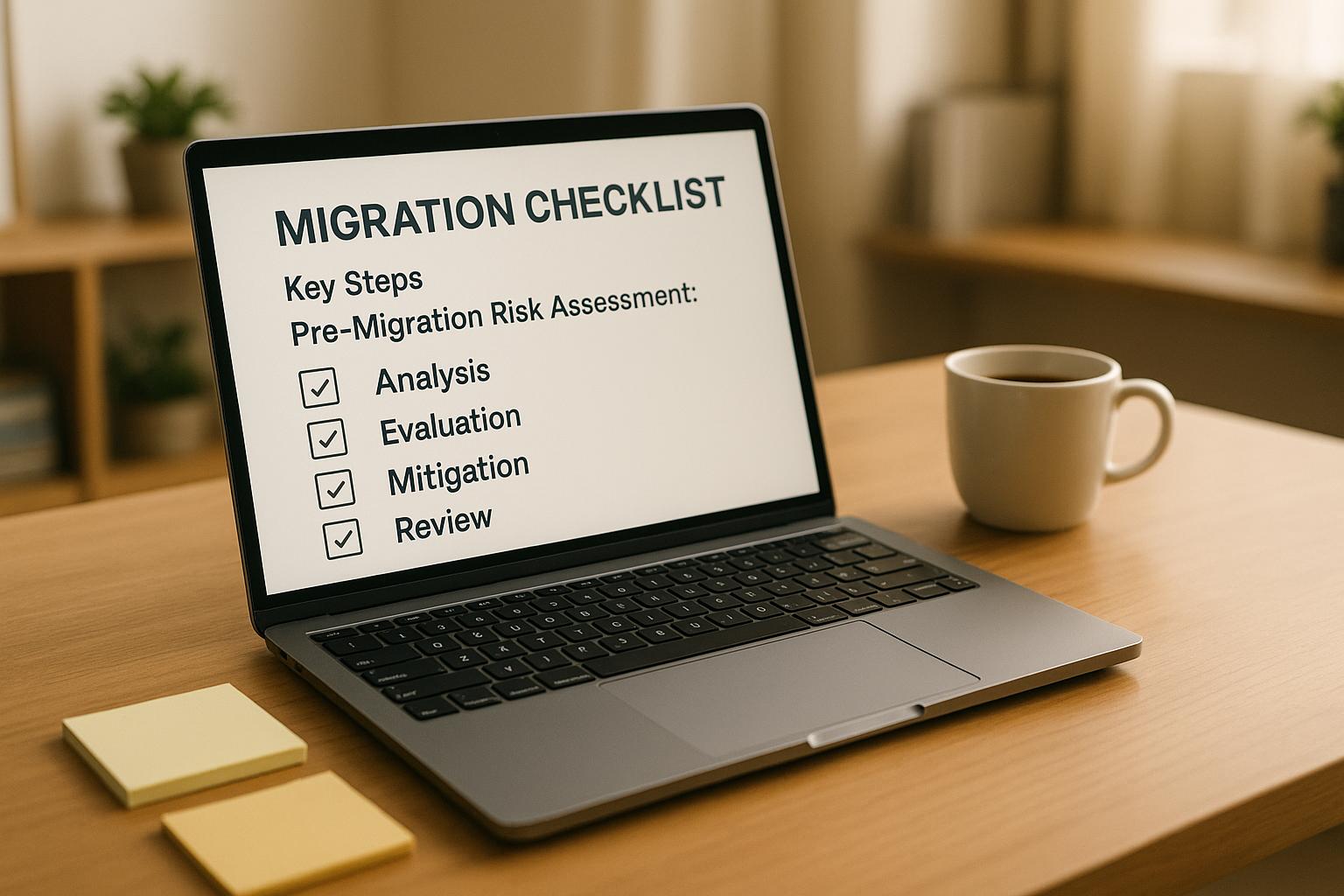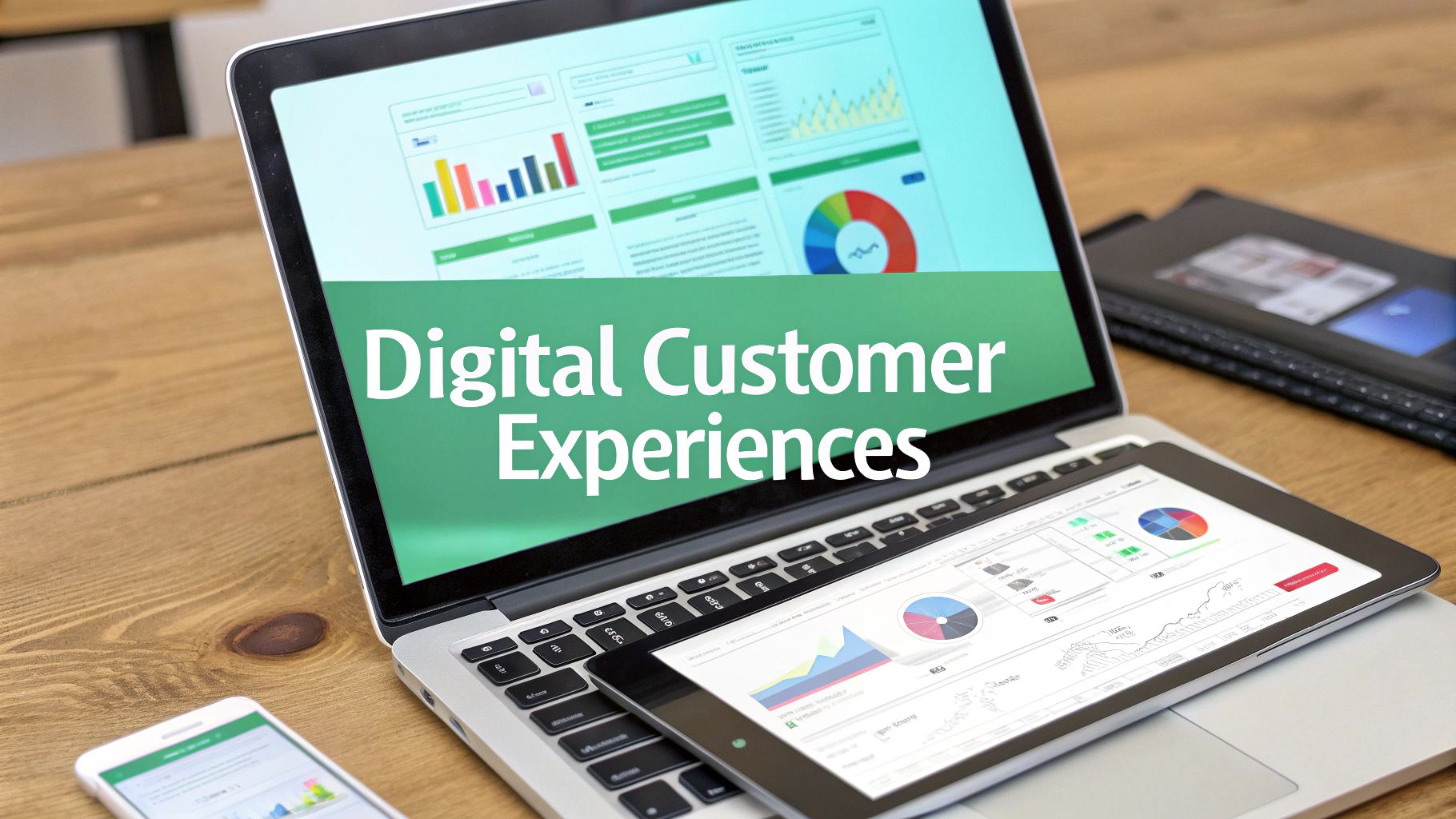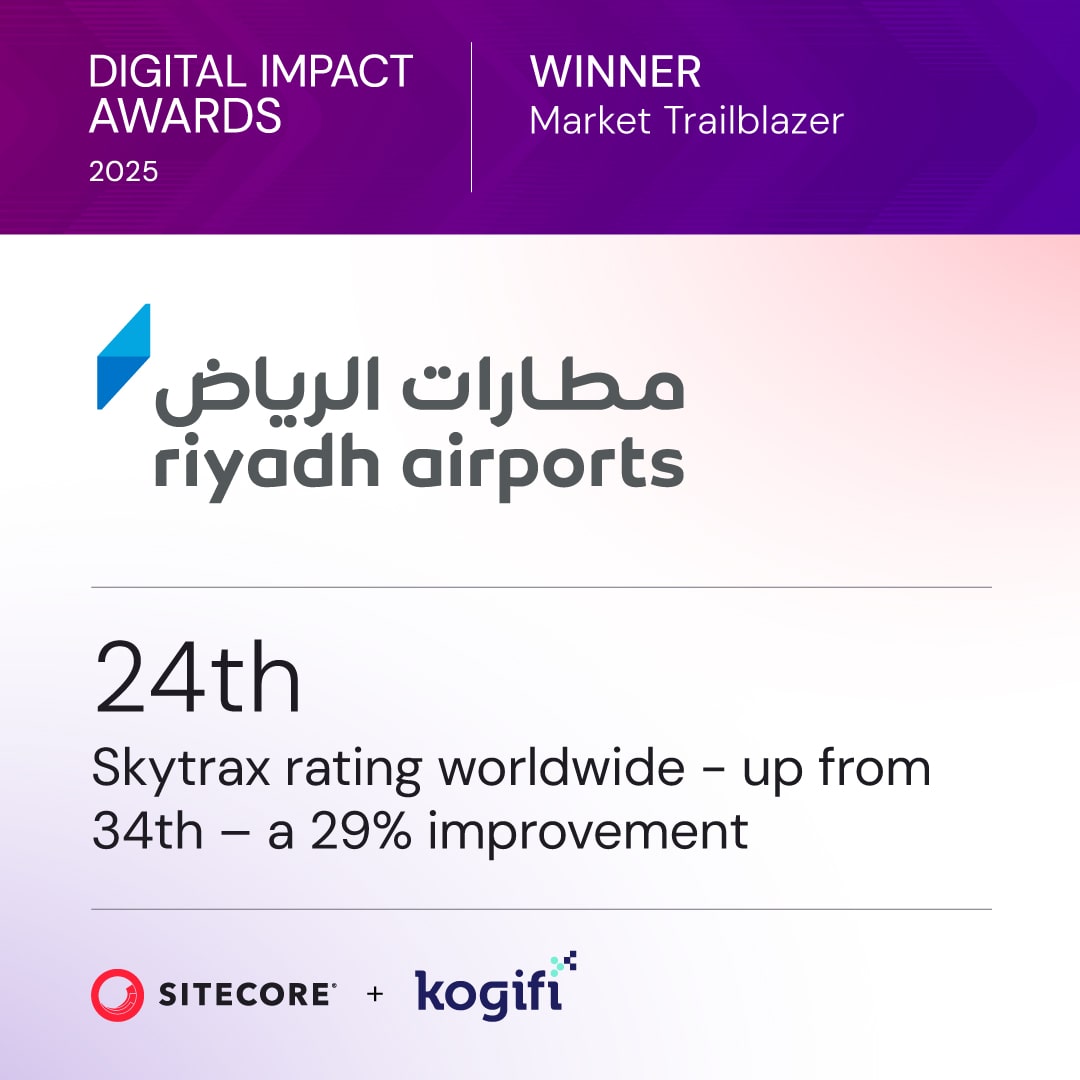Migrating platforms is no small feat - it can disrupt operations, overrun budgets, and strain teams if not planned carefully. A pre-migration risk assessment helps you avoid these pitfalls by identifying risks, mapping dependencies, and creating mitigation plans upfront. Here's what you need to know:
- Clarify Goals: Define why you're migrating and set measurable success criteria (e.g., reduce page load times or enable faster updates).
- Assess Impact: Identify how migration affects teams, workflows, and operations, including downtime tolerance and training needs.
- Map System Dependencies: Document all APIs, data flows, and integrations to avoid cascading failures.
- Inventory IT Assets: List all tech components, classify by importance, and track dependencies to prioritize efforts.
- Identify Risks: Common issues include data loss, downtime, integration failures, and compliance gaps. Use a risk matrix to prioritize them.
- Plan for Security and Compliance: Protect data with encryption, access controls, and monitoring, while ensuring regulatory requirements are met.
- Backup and Rollback Plans: Test backups and define clear rollback procedures to recover quickly if issues arise.
- Monitor Progress: Use KPIs and real-time monitoring to track performance and detect problems early.
Skipping this process can lead to costly surprises, but thorough preparation ensures smoother transitions and builds stakeholder confidence.
#2 Cloud Assessment: 4 Dimensions to Consider when Assessing IT for the Cloud
Define Migration Goals and Business Impact
Before diving into the technical details, it’s crucial to clarify why you’re migrating and what success looks like. This step sets the foundation for every decision you’ll make and ensures your migration delivers measurable value to your organization.
Set Clear Business Goals
Your migration goals should tie directly to your broader business objectives - not just technical upgrades. Start by identifying and quantifying key pain points, like losses from downtime or delays in content updates, and use these to set clear, measurable success criteria.
For example, instead of saying "improve user experience", set specific goals like:
- Reduce page load times from 8 seconds to under 3 seconds.
- Enable faster content updates, allowing marketing teams to publish changes within 30 minutes instead of 3 days.
These actionable targets serve as a guiding light throughout the migration process, helping you prioritize and make trade-offs when needed.
Think beyond immediate wins. While faster performance might be a short-term goal, consider the long-term capabilities you want to unlock. Will the new platform support AI-driven personalization? Can it handle surges in traffic as your business scales? Will it integrate more seamlessly with your CRM or marketing automation tools? These questions shape your migration strategy.
Once you’ve defined your objectives, evaluate how the migration might impact various departments and workflows across your organization.
Assess Impact on Operations
Begin by mapping out all teams and processes that rely on your current platform. While IT and marketing are obvious stakeholders, don’t overlook others like:
- Customer service teams who access product information.
- Sales teams that depend on lead capture forms.
- External partners with system integrations.
Next, assess the potential operational disruptions during each migration phase. For example:
- Will content creators lose access to their tools temporarily?
- How might customer-facing systems, like your website or app, be affected?
- If URL structures change, what happens to your SEO rankings?
Downtime tolerance is another critical factor. For instance, an e-commerce site might lose thousands of dollars per minute during an outage, while an internal knowledge base might handle a few hours of downtime during off-peak hours. Document these tolerances for each system component to guide your migration strategy and backup planning.
Finally, factor in training and change management. A new platform often means new workflows, and your teams will need time to adapt. Plan for a temporary dip in productivity as users get up to speed, and build this learning curve into your timeline.
Once you’ve mapped operational impacts, shift your focus to the technical backbone of your digital ecosystem.
Map Critical System Connections
Modern platforms rarely operate in isolation - they’re part of a web of interconnected tools, databases, and services. These integrations are often the most sensitive areas during migration, as a single broken connection can ripple through other systems.
Create a detailed list of all API connections, data feeds, and third-party services, ranking them by importance and complexity. Document how data flows between systems to quickly identify potential bottlenecks. This includes obvious integrations like CRM systems or payment processors, but also less visible ones like analytics tools, security monitoring systems, and automated backups.
Pay extra attention to real-time integrations that can’t tolerate delays or disruptions. Systems like live chat, payment processing, or inventory updates often require special handling to ensure continuous operation during the migration. In some cases, you may need to run these systems in parallel or use specialized migration techniques to maintain uninterrupted service.
Catalog and Review Current IT Assets
Once you've outlined your business goals and mapped system connections, the next step is to get a clear understanding of what you're migrating. A detailed inventory of your IT assets is essential to gauge the scope, complexity, and risks involved in moving each component to a new platform.
Create an IT Asset Inventory
Start by listing every technology that interacts with your platform. This includes not just the obvious elements like databases and applications but also the less visible ones - scripts, workflows, configuration files, and more.
Automated discovery tools can be a game-changer here, helping you find legacy systems and hidden integrations that manual documentation might miss. These overlooked connections often play critical roles, and missing them could cause significant issues during migration.
For each asset, make sure to capture key details such as:
- Current version numbers
- Last update dates
- Storage requirements
- Performance metrics
- Database size and growth trends
- Backup frequency and methods
- User counts and peak usage times
- Customizations that deviate from standard setups
Don’t forget to include external data stores and file repositories, like shared drives or archived content, as they might add unexpected layers of complexity to the migration process.
To streamline this process, consider using ADM platforms for automated asset tracking. With a complete inventory in hand, you'll be better equipped to assess the importance of each component and set migration priorities.
Classify Assets by Business Value
Not every system carries the same weight in your operations. Rank each asset based on two factors: its importance to your daily activities and how challenging it would be to replace if something goes wrong during the migration.
Create categories to reflect both business impact and technical complexity. For example, mission-critical systems - like your customer-facing website or primary database - should be at the top of your priority list. Secondary or supporting systems can be assigned lower priority.
Forrester research shows that more than half of enterprises struggle with limited visibility into their assets. This highlights why thorough classification is so crucial.
Also, think about the potential financial consequences of downtime and the effort required to rebuild or replace each system if migration issues arise. This classification will help guide your dependency mapping and risk assessment efforts.
Identify System Dependencies
With your asset inventory and classifications complete, the next step is to map out how these systems interact. Understanding system dependencies is critical - overlooked connections can lead to cascading failures during migration.
ADM tools can simplify this process by automatically mapping dependencies and tracking changes. They provide insights into data flows, backup requirements, and your current application architecture, making it easier to determine what data needs to move and how to structure your migration plan.
To improve visibility, ensure your documentation is clear, up-to-date, and comprehensive. Use consistent tagging and naming conventions in your configuration files, and manage access controls for your mapping tools carefully to maintain security.
Identify and Analyze Migration Risks
Identifying potential migration risks is a critical step in ensuring a smooth transition. A structured approach to spotting these challenges helps you address them early, preventing small issues from snowballing into costly setbacks.
Common Migration Risks
Migration projects come with a variety of risks that can disrupt timelines, inflate budgets, and interfere with operations. Recognizing these risks upfront is key to managing them effectively.
- Data loss and corruption: Transferring data from legacy systems can lead to incomplete or corrupted transfers, especially when dealing with incompatible formats.
- Extended downtime: Even brief maintenance windows can unexpectedly stretch into prolonged outages, disrupting operations and damaging your organization's reputation.
- Integration failures: Third-party systems, APIs, or custom applications may not connect as expected, whether during testing or once the system is live.
- Performance issues: The new platform might struggle to handle workloads efficiently. For example, database queries that previously ran smoothly may experience delays, or page load times could increase under normal conditions.
- User adoption challenges: Employees may resist new interfaces or struggle with missing functionalities they relied on previously. Without proper training, productivity can take a hit.
- Budget overruns: Scope creep, extended timelines, or unexpected complications often lead to higher costs than initially planned.
- Security vulnerabilities: Temporary configurations, elevated permissions, or data synchronization during migration can create gaps in security, exposing the system to potential threats.
- Compliance violations: Industries like healthcare and finance must meet strict regulatory standards. Failing to address these requirements during migration could result in costly penalties.
Once you’ve identified these risks, the next step is to assess and prioritize them effectively.
Use a Risk Matrix for Priority Setting
A risk matrix is a practical tool for evaluating and prioritizing migration risks. By assigning scores for likelihood and impact, you can focus your efforts on the most pressing challenges.
Start by creating a grid with likelihood on one axis and impact on the other. Use a scale from 1 (low) to 5 (high) for both dimensions. Here's how to approach the scoring:
- Likelihood: Consider factors like the complexity of the migration, your team’s experience, the maturity of the target platform, and the reliability of current systems. For example, moving multiple undocumented legacy databases might score higher on likelihood than migrating a single, well-documented application.
- Impact: Think about immediate and long-term consequences, such as financial costs, operational disruptions, effects on customer experience, regulatory risks, and recovery time. Issues affecting revenue-generating systems typically score higher than those impacting internal processes.
Once you’ve rated each risk, plot it on the matrix. Risks with higher combined scores demand immediate attention, while moderate risks require monitoring and contingency plans. Lower-scoring risks can be documented but usually don’t need extensive preparation.
- High-priority risks: These include data corruption in essential systems, extended downtime for public-facing platforms, and integration failures with critical applications. These require dedicated mitigation strategies, thorough testing, and clear rollback procedures.
- Medium-priority risks: Examples include performance issues in non-critical systems, minor compliance gaps that can be resolved later, or limited user adoption challenges. These should be monitored closely but typically won’t delay the migration.
- Low-priority risks: These might involve minor functionality differences or issues affecting smaller user groups. While they should be noted, they generally don’t require significant resources to address.
As the migration progresses, revisit and update the risk matrix. Testing may uncover new risks, and the likelihood or impact of existing ones might shift as mitigation measures are implemented or new information comes to light.
This systematic approach ensures that resources are allocated wisely, keeps stakeholders informed, and provides a clear framework for making critical decisions throughout your migration process.
sbb-itb-91124b2
Review Security, Compliance, and Governance
Once you've identified and prioritized migration risks, the next step is addressing security, compliance, and governance. These elements are crucial to maintaining operational integrity. Failing to secure these areas can lead to data breaches, non-compliance penalties, and reputational damage. By building on your risk assessment, you can create a strong foundation for a successful migration.
Protect Data Security
Migrating data often creates temporary vulnerabilities that attackers might exploit. To safeguard your information, you need a multi-layered approach that secures data at every stage.
- Encryption: Encrypt data in transit, at rest, and during synchronization to ensure it's protected at all times.
- Access controls: Use the principle of least privilege - grant only the minimum access required for migration tasks. Create temporary accounts specifically for the migration process, and disable them once the work is complete.
- Real-time monitoring: Set up alerts to detect unusual activity, such as unauthorized access or unexpected data transfers. Pay special attention to after-hours activity or connections from unfamiliar locations.
- Data masking: For testing purposes, mask sensitive data like Social Security numbers or credit card details. This allows validation without exposing actual information. Tokenization can also replace sensitive data with placeholders during testing.
- Network segmentation: Isolate migration servers from production systems. Limit communication pathways to only what's necessary, reducing the risk of security incidents spreading across your network.
Check Compliance Requirements
Compliance is non-negotiable, especially when you're handling regulated data. Your migration plan must align with industry-specific standards like GDPR, HIPAA, SOX, and PCI DSS. Here's how to address some of the most common compliance needs:
- GDPR: Ensure personal data maintains the same level of protection during migration. Document all processing activities, and make sure data subject rights remain intact.
- HIPAA: For healthcare organizations, document the entire migration process as part of your risk assessment. Verify that all third-party partners meet HIPAA's security requirements, and ensure temporary storage locations are secure.
- SOX and PCI DSS: Financial services must maintain data integrity, audit trails, and system availability. This often requires phased migration approaches or parallel systems to avoid disruptions.
- Other industry standards: Sectors like education (FERPA) and pharmaceuticals (FDA regulations) often demand additional documentation, validation, and change control processes. Plan for these requirements early to avoid compliance gaps.
To stay organized, create a compliance mapping document. This matrix should outline how you'll meet each regulatory requirement, who is responsible, and what validation methods you'll use. This documentation can streamline audits and ensure nothing is overlooked.
Review Governance Structures
Governance is the backbone of a well-executed migration. It ensures accountability, keeps the project on track, and prevents delays or budget overruns. Without clear governance, migrations can quickly spiral out of control.
- Define roles and responsibilities: Use a RACI matrix (Responsible, Accountable, Consulted, Informed) to clarify who does what. This covers technical execution, security oversight, compliance validation, and business approvals.
- Steering committee: Form a committee with representatives from IT, business, security, compliance, and executive teams. Regular meetings - beyond just major milestones - help address risks and resource needs promptly.
- Change control processes: Avoid scope creep by implementing formal procedures for evaluating and approving changes to the migration plan. This applies to technical adjustments, timelines, and resource allocations.
- Comprehensive documentation: Track every decision, risk, and configuration change. Use version control to keep documentation up-to-date and ensure all stakeholders have access to the latest information.
- Communication protocols: Tailor updates to your audience. Executives need high-level summaries of timelines and risks, while technical teams require detailed progress reports.
- Audit trails: Keep detailed records of system changes, data transfers, and access permissions. These logs are invaluable for compliance audits and troubleshooting post-migration issues.
- Independent oversight: Consider third-party audits or internal reviews for an unbiased assessment of your governance and compliance efforts. Fresh eyes can catch gaps the core team might miss.
- Escalation procedures: Clearly define how and when issues should be escalated to higher authorities. Make sure everyone on the team understands these procedures.
Create Mitigation and Backup Plans
Even with solid security, compliance, and governance frameworks in place, migrations can still face unexpected challenges. From system crashes to data corruption, unforeseen issues can disrupt the process. That’s why having well-thought-out mitigation and backup plans is critical - not just for keeping operations running but also for safeguarding your organization's reputation.
Backup and Recovery Plans
A strong backup plan is your safety net during migration. It ensures that even if something goes wrong, you can recover without losing critical data or enduring prolonged downtime, which could lead to costly disruptions.
Start by creating full system snapshots and incremental backups throughout the migration. These backups preserve not only your data but also system states, user permissions, and custom configurations. Scheduling backups during low-traffic times helps reduce the impact on production systems.
If issues arise, you can restore from the most recent validated backup instead of starting over. This approach saves time and ensures you don’t lose progress. Regularly test your backups in isolated environments to confirm they’re complete and functional. Many organizations only discover backup issues - like missing files or corruption - when it’s too late. Testing also helps verify that the restored systems operate as expected and pass all data integrity checks. Documenting the time required for each restore operation is equally important, as this informs your recovery time objectives.
To add another layer of protection, store backups in multiple locations. Using geographically distributed data centers or cloud regions ensures availability even if your primary site encounters problems. Keep in mind the bandwidth needed to move large backup files between locations, as this could affect recovery speed during critical moments.
Finally, outline rollback procedures to quickly undo changes if something goes wrong.
Define Rollback Procedures
Rollback procedures are your contingency plan for reversing migration changes when unexpected problems arise. These procedures must be clear, thoroughly tested, and executable under tight deadlines.
Start by defining specific criteria for when a rollback should be triggered. For instance, set thresholds for system performance, error rates, or other key metrics. If these thresholds are exceeded, the rollback process should kick in immediately, removing any guesswork during high-pressure situations.
Document detailed, step-by-step rollback instructions for each migration phase. Include commands, configuration changes, and database scripts needed to reverse actions. Assign roles and responsibilities so that team members know exactly what to do, even if the original migration lead is unavailable.
Your rollback timeframes will depend on your migration strategy. For phased migrations, you may have more time to evaluate and act, while big-bang migrations require quicker decisions. Testing rollback procedures in a staging environment that mirrors production is crucial. This helps you identify bottlenecks and refine the process so your team can act swiftly when needed.
Set KPIs and Monitoring Systems
Once your backup and rollback plans are in place, monitoring becomes essential to ensure the migration stays on track. Establish key performance indicators (KPIs) to detect potential issues early, giving you the ability to decide whether to proceed, pause, or roll back.
Track system performance metrics like response times, throughput, error rates, and resource utilization. Use your current environment as a baseline to quickly spot anomalies in the new system. Monitoring CPU usage, memory, disk I/O, and network bandwidth will help ensure the new infrastructure can handle your workloads.
Data integrity checks are equally important. Automated scripts that compare record counts, checksums, or key data fields between the source and destination systems can catch errors early. Set up alerts for any discrepancies to address problems before they escalate.
Don’t overlook the user experience. Metrics like login success rates, page load times, and transaction completion rates can reveal issues that technical data might miss. Pair these with user surveys to gather qualitative feedback.
It’s also important to monitor how the migration impacts key business processes, such as order fulfillment or customer service. These indicators help translate technical performance into business outcomes.
Real-time dashboards can consolidate all this monitoring data into easy-to-read visualizations. Tailor dashboards for different roles: technical teams might need detailed metrics, while executives benefit from high-level summaries. Automated alerts, prioritized by severity, ensure problems are addressed promptly.
Lastly, make sure your monitoring systems function independently of your primary systems. This guarantees you maintain visibility even during failures, allowing you to respond effectively and keep the migration stable.
For expert advice on designing robust migration strategies, organizations can explore the resources and services offered by Kogifi.
Conclusion: Planning for Migration Success
Achieving a smooth platform migration hinges on careful planning and thorough risk evaluation. The steps laid out in this guide provide a solid framework to minimize migration failures and avoid unexpected downtime that could disrupt your operations.
The importance of a detailed pre-migration risk assessment cannot be overstated. By identifying threats, dependencies, and compliance gaps ahead of time, organizations can significantly reduce the chances of failure, downtime, and operational disruptions. Skipping this critical phase often leads to costly surprises that could have been avoided with proper preparation.
To ensure success, focus on these key checkpoints: establish clear business objectives and success criteria, align the migration scope with measurable outcomes, and create a complete inventory of assets, data volumes, integrations, and permissions to pinpoint high-risk areas.
Security, compliance, and governance demand special attention. Before the migration begins, validate cryptographic controls, access mappings, and incident response plans. A final review should confirm that all controls are effective and aligned with compliance requirements to avoid post-migration vulnerabilities or audit issues.
The most common pitfalls during migrations include data loss or corruption, extended downtime beyond SLA limits, integration breakdowns, performance issues, incorrect permission settings, and compliance breaches. Use a risk matrix that factors in likelihood, impact, and potential financial losses - such as revenue lost per hour of downtime - to prioritize mitigation strategies and establish rollback criteria.
With over 85% of enterprises expected to operate most of their workloads in the cloud, migration projects are only becoming more frequent. This growing trend, combined with increasingly sophisticated cyber threats, underscores the need for proactive and thorough risk assessments.
Before moving forward, confirm these essential elements are ready: a business case with cost limits in USD, downtime schedules aligned with local time zones, data volumes formatted using US conventions (e.g., 1,250,000 records), recovery objectives that meet SLA standards, security and compliance sign-offs, rehearsed backup and rollback plans, and monitoring systems with active on-call teams.
Thoughtful pre-migration planning pays off in the form of smoother transitions and more predictable outcomes. For expert support with migration strategies, Kogifi offers specialized services in digital experience platforms and enterprise CMS solutions.
FAQs
What are the key risks to address during a pre-migration assessment, and how can they be mitigated effectively?
When preparing for a platform migration, there are several major risks to keep in mind: data loss, system incompatibility, security vulnerabilities, and operational disruptions. If not carefully managed, these issues can result in costly delays, compliance headaches, or even a failed project.
To tackle these risks head-on, start by conducting a detailed risk assessment to pinpoint potential problems early. Make sure to run extensive tests to confirm system compatibility and protect data integrity. Always have a solid rollback plan in place to address unexpected failures, and safeguard sensitive information with encryption while following compliance requirements. Thoughtful planning and meticulous preparation are key to a migration process that runs smoothly and avoids unnecessary setbacks.
What steps can organizations take to ensure compliance with regulations like GDPR or HIPAA during a platform migration?
When navigating a platform migration while adhering to regulations like GDPR or HIPAA, organizations need to take certain essential steps to ensure compliance:
- Perform a data audit: Identify and categorize sensitive information to ensure it's managed according to legal requirements.
- Obtain required consents: Secure permissions from users and stakeholders in line with applicable laws.
- Protect data transfers: Use encryption and other security measures to prevent unauthorized access during the migration.
- Maintain thorough documentation: Keep detailed records of compliance efforts to demonstrate adherence to regulatory standards.
Beyond these steps, it's crucial to conduct regular risk assessments, provide staff with training on data privacy, and establish clear protocols for handling personal information. These practices not only protect sensitive data but also strengthen trust with users and stakeholders throughout the migration process.
What are the key steps to building a complete IT asset inventory before starting a migration?
Creating a detailed IT asset inventory is a key step to ensure your migration process runs smoothly. Begin by listing all hardware, software, and digital assets, noting specifics like versions, licenses, and configurations. Leveraging IT Asset Management tools can make this task easier and help you maintain an up-to-date inventory over time.
It's also important to conduct thorough audits to uncover outdated or unused assets - often called 'ghost' assets. Adopt clear naming conventions and document the full lifecycle of each asset, from purchase to decommissioning. This detailed approach improves visibility, minimizes risks, and ensures compliance, setting the stage for a more seamless migration.








































